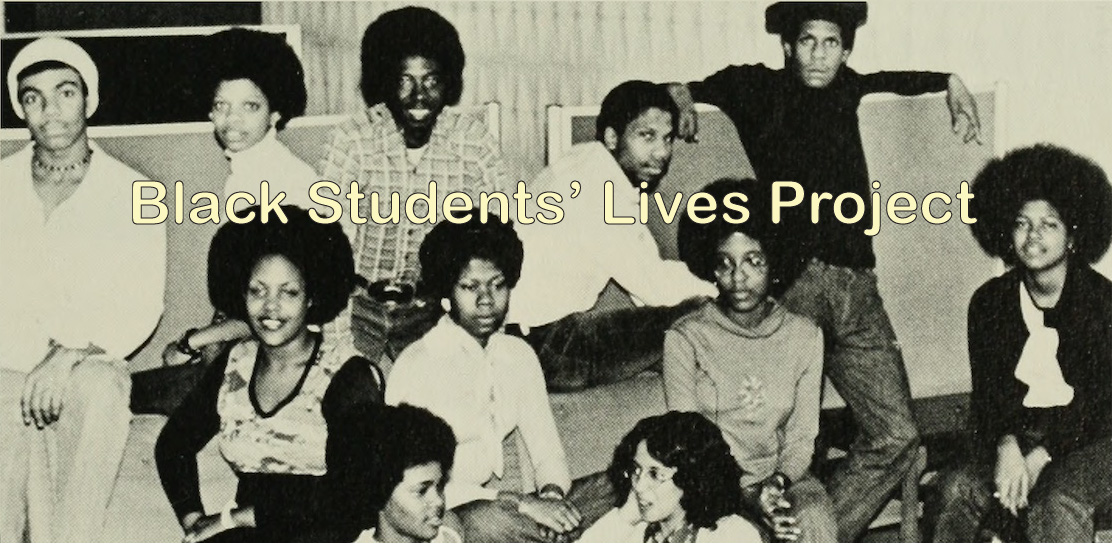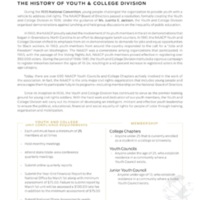NAACP Youth and College Resource Guide, Appendix A: THE HISTORY OF YOUTH & COLLEGE DIVISION
Title
NAACP Youth and College Resource Guide, Appendix A: THE HISTORY OF YOUTH & COLLEGE DIVISION
Subject
NAACP
Creator
NAACP
Source
www.naacp.org
Date
2010
Contributor
Marlene Miller
Language
English
Text
Appendix A
THE HISTORY OF YOUTH & COLLEGE DIVISION
During the 1935 National Convention, young people challenged the organization to provide youth with a
vehicle to address civil rights. The NAACP Board of Directors passed a resolution, formally creating the Youth
and College Division in 1936. Under the guidance of Ms. Juanita E. Jackson, the Youth and College Division
organized demonstrations against lynching and held group discussions on the inequality of public education.
In 1960, the NAACP proudly saluted the involvement of its youth members in the sit-in demonstrations that
began in Greensboro, North Carolina in an effort to desegregate lunch counters. In 1961, the NAACP Youth and
College Division shifted its emphasis from sit-in demonstrations to demands for jobs and equal opportunities
for Black workers. In 1963, youth members from around the country responded to the call for a “Jobs and
Freedom” march on Washington. The NAACP was a cornerstone among organizations that participated. In
1965, with the passage of the Voting Rights Act, NAACP youth members proved effective in registering over
350,000 voters. During the period of 1966-1981, the Youth and College Division instituted a vigorous campaign
to register minorities between the ages of 18-24; resulting in a 40 percent increase in registered voters in this
age category.
Today, there are over 600 NAACP Youth Councils and College Chapters actively involved in the work of
the association. In fact, the NAACP is the only major civil rights organization that includes young people and
encourages them to participate fully in its programs—including membership on the National Board of Directors.
Since its inception in 1936, the Youth and College Division has continued to serve as the premier training
ground for young civil rights soldiers. With the hard work and dedication of our youth members, the Youth and
College Division will carry out its mission of developing an intelligent, militant and effective youth leadership
to ensure the political, educational, financial and social equality of rights for people of color through training,
organization and mobilization.
YOUTH AND COLLEGE
UNIT COMPLIANCE REQUIREMENTS
• Each unit must have a minimum of 25
members at all times
• Hold monthly meetings
• Attend state/state-area conference
quarterly meetings
• Submit online quarterly reports
• Submit the Year-End Financial Report to the
National Office by March 1st along with minimum
assessment of $75.00. Failure to submit report by
March 1st unit will be assessed a $100.00 late fee
in addition to the minimum assessment of $75.00
• Submit National/State Assessments yearly
MEMBERSHIP
College Chapters
• Anyone under 25 that is currently enrolled
as a student in a college or University.
Youth Councils
• Anyone under the age of 25, who establish
residence in a community where a
Youth Council exists.
Junior Youth Council
• Anyone under age of 13, who establish
residence in a community where a Junior
Youth Council exists.
THE HISTORY OF YOUTH & COLLEGE DIVISION
During the 1935 National Convention, young people challenged the organization to provide youth with a
vehicle to address civil rights. The NAACP Board of Directors passed a resolution, formally creating the Youth
and College Division in 1936. Under the guidance of Ms. Juanita E. Jackson, the Youth and College Division
organized demonstrations against lynching and held group discussions on the inequality of public education.
In 1960, the NAACP proudly saluted the involvement of its youth members in the sit-in demonstrations that
began in Greensboro, North Carolina in an effort to desegregate lunch counters. In 1961, the NAACP Youth and
College Division shifted its emphasis from sit-in demonstrations to demands for jobs and equal opportunities
for Black workers. In 1963, youth members from around the country responded to the call for a “Jobs and
Freedom” march on Washington. The NAACP was a cornerstone among organizations that participated. In
1965, with the passage of the Voting Rights Act, NAACP youth members proved effective in registering over
350,000 voters. During the period of 1966-1981, the Youth and College Division instituted a vigorous campaign
to register minorities between the ages of 18-24; resulting in a 40 percent increase in registered voters in this
age category.
Today, there are over 600 NAACP Youth Councils and College Chapters actively involved in the work of
the association. In fact, the NAACP is the only major civil rights organization that includes young people and
encourages them to participate fully in its programs—including membership on the National Board of Directors.
Since its inception in 1936, the Youth and College Division has continued to serve as the premier training
ground for young civil rights soldiers. With the hard work and dedication of our youth members, the Youth and
College Division will carry out its mission of developing an intelligent, militant and effective youth leadership
to ensure the political, educational, financial and social equality of rights for people of color through training,
organization and mobilization.
YOUTH AND COLLEGE
UNIT COMPLIANCE REQUIREMENTS
• Each unit must have a minimum of 25
members at all times
• Hold monthly meetings
• Attend state/state-area conference
quarterly meetings
• Submit online quarterly reports
• Submit the Year-End Financial Report to the
National Office by March 1st along with minimum
assessment of $75.00. Failure to submit report by
March 1st unit will be assessed a $100.00 late fee
in addition to the minimum assessment of $75.00
• Submit National/State Assessments yearly
MEMBERSHIP
College Chapters
• Anyone under 25 that is currently enrolled
as a student in a college or University.
Youth Councils
• Anyone under the age of 25, who establish
residence in a community where a
Youth Council exists.
Junior Youth Council
• Anyone under age of 13, who establish
residence in a community where a Junior
Youth Council exists.
Files
Reference
NAACP 2010, NAACP Youth and College Resource Guide, Appendix A: THE HISTORY OF YOUTH & COLLEGE DIVISION


